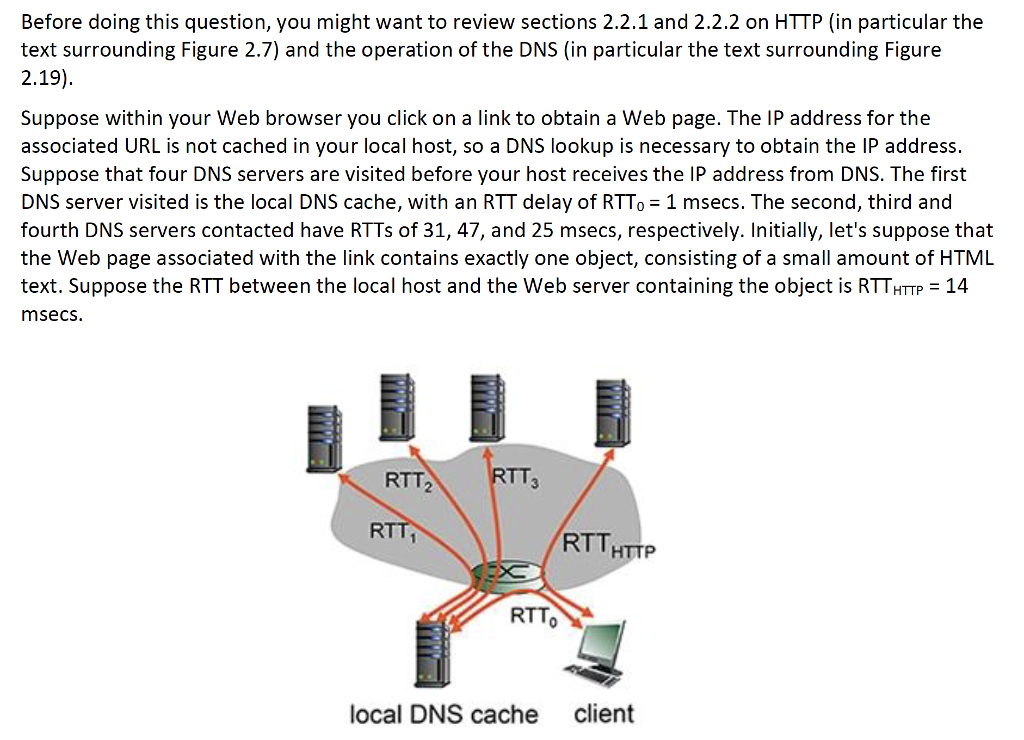Question
1. Assuming zero transmission time for the HTML object, how much time elapses from when the client clicks on the link until the client receives

1. Assuming zero transmission time for the HTML object, how much time elapses from when the client clicks on the link until the client receives the object?
2. Now suppose the HTML object references 7 very small objects on the same web server. Neglecting transmission times, how much time elapses from when the client clicks on the link until the base object and all 7 additional objects are received from web server at the client, assuming non-persistent HTTP and no parallel TCP connections?
3. Repeat 2. above but assume that the client is configured to support a maximum of 5 parallel TCP connections, with non-persistent HTTP.
4. Repeat 2. above but assume that the client is configured to support a maximum of 5 parallel TCP connections, with persistent HTTP.
5. What do you notice about the overall delays (taking into account both DNS and HTTP delays) that you computed in cases 2., 3. and 4. above?
Why is it that voice and video traffic is often sent over TCP rather than UDP in todays Internet? (Hint: the answer we are looking for has nothing to do with TCPs congestion-control mechanism.)
Before doing this question, you might want to review sections 2.2.1 and 2.2.2 on HTTP (in particular the text surrounding Figure 2.7) and the operation of the DNS (in particular the text surrounding Figure 2.19) Suppose within your Web browser you click on a link to obtain a Web page. The IP address for the associated URL is not cached in your local host, so a DNS lookup is necessary to obtain the IP address. Suppose that four DNS servers are visited before your host receives the IP address from DNS. The first DNS server visited is the local DNS cache, with an RTT delay of RTTo 1 msecs. The second, third and fourth DNS servers contacted have RTTs of 31, 47, and 25 msecs, respectively. Initially, let's suppose that the Web page associated with the link contains exactly one object, consisting of a small amount of HTML text Suppose the RTT between the local host and the web server containing the object is RTTHTTP = 14 msecs. RTT2 RTT RTTHTTP RTT local DNS cache client Before doing this question, you might want to review sections 2.2.1 and 2.2.2 on HTTP (in particular the text surrounding Figure 2.7) and the operation of the DNS (in particular the text surrounding Figure 2.19) Suppose within your Web browser you click on a link to obtain a Web page. The IP address for the associated URL is not cached in your local host, so a DNS lookup is necessary to obtain the IP address. Suppose that four DNS servers are visited before your host receives the IP address from DNS. The first DNS server visited is the local DNS cache, with an RTT delay of RTTo 1 msecs. The second, third and fourth DNS servers contacted have RTTs of 31, 47, and 25 msecs, respectively. Initially, let's suppose that the Web page associated with the link contains exactly one object, consisting of a small amount of HTML text Suppose the RTT between the local host and the web server containing the object is RTTHTTP = 14 msecs. RTT2 RTT RTTHTTP RTT local DNS cache clientStep by Step Solution
There are 3 Steps involved in it
Step: 1

Get Instant Access to Expert-Tailored Solutions
See step-by-step solutions with expert insights and AI powered tools for academic success
Step: 2

Step: 3

Ace Your Homework with AI
Get the answers you need in no time with our AI-driven, step-by-step assistance
Get Started


